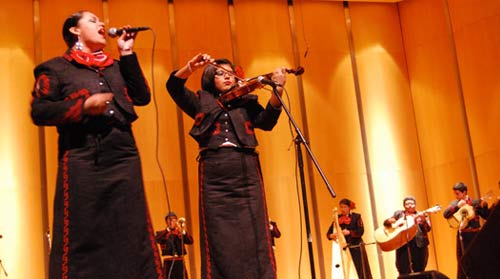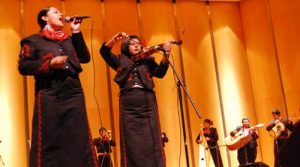Mariachi Music Gaining Credibility in Texas Schools

 By Jason Margolis, New America Media/PRI’s The World
By Jason Margolis, New America Media/PRI’s The World
Mariachi music is a quintessential sound of Mexico. But in Mexico, it’s a style of folk music that’s never been taken all that seriously and certainly not among music educators. It’s considered bar music, unworthy of academic study. But it’s becoming a different story just north of the border in Texas.
Click here to listen to an audio version of this story.
 The story of mariachi music in Texas schools begins with Belle San Miguel Ortiz.
The story of mariachi music in Texas schools begins with Belle San Miguel Ortiz.
“There are several names that they’ve given me, from godmother to the queen of the mariachis, to la madrina, which is the same thing,” said Ortiz. “I was the very first teacher of mariachi anywhere in the world.”
That’s a tough thing to prove. But Ortiz stands by that claim. “A lot of people will say you’re not the first. Yes, I am.”
When Ortiz first started teaching music in Texas high schools, some people didn’t like what she was doing. “We’re talking about the late 50’s, when discrimination was at its highest. And many of my colleagues reported me saying that I was teaching choir but everything was in Spanish.”
As a Mexican American living in Texas though, she thought Mexican folk music was important. “I couldn’t understand why mariachi music was not taught, especially I thought in this area.”
Finally in 1970, Ortiz got permission to teach a high school mariachi class. It’s come a long way since then.
When I met Ortiz, who is now 79, she was judging a regional competition for a statewide high school mariachi contest.
Ten bands from South Texas participated in the competition. Each had about a dozen members. The boys wore ornate, embroidered suits and the girls wore floor length skirts, sashes, and jackets. The outfits were sewn with elaborate patterns and shiny buttons. The kids looked sharp.
They played violins, trumpets, and guitars. Students also played the two key mariachi instruments: The guitarrón – essentially an enormous guitar – and the vihuela, a small guitar. There was also the occasional harpist and flute player.
High school junior Jonathan Rivera nailed a fantastic harp solo.
“I went up there, and we were playing, and I was like okay, calm down, you’ve done this before,” said Rivera after his performance. “And then we started the song, it wasn’t even close to the solo, we just started the song, and I was already like, ooooh, it hit me, and I was like ‘Oh My Gosh,’ and I got nervous.”
If Rivera and the other students were nervous, it didn’t show. The students also took turns walking to center stage and belting out solos. I kept forgetting that I was watching 15, 16, and 17-year-olds up on stage.
They were great.
“Mariachi is more performing,” said Rivera. “You’re actually like a Broadway show, you go and you sing, and you act. When you go into mariachi, you could have the worst day of your life, your dog died, your parents are in the hospital, and your girlfriend left you, and you’re like oh you have a performance today, forgot about that. And you can’t go on stage, with your face all frowning and what not, you gotta go up there and smile, you gotta do that.”
Rivera also plays in a rock band. But like many of the students I met, he said he gravitated to mariachi because it connects him to his Mexican roots. Senior Celia Vallez chose mariachi as an elective in the sixth grade.
“And the primary reason was that the majority of my family doesn’t speak English, so I felt it was really a way for me to connect to them and back to my Mexican roots and heritage.”
Like other students I met, Vallez’ Spanish was not the best.
“Spanish is actually my first language, but over the years, I haven’t been able to use it as often. It still comes, but it’s not as naturally,” said Vallez. She said mariachi “definitely” helps.
Still, there are some who don’t understand this embrace of mariachi. I heard tales of parents who were upset that their children were wasting their time on this cantina music. It’s seen as kind of a joke by many, not worthy of musical study.
Texas State University in San Marcos is trying to change that attitude. It’s offering classes in mariachi methods and history. Undergraduates can earn a teaching certificate in mariachi music. And the school plans to offer a summertime masters program in mariachi in the near future.
When mariachi was first introduced there in the 1990’s, it was student taught.
“Then I went to the school of music and said, we need to take this class seriously like any other ensemble. You would never do this to orchestra, orchestra would never be student run with a faculty adviser,” said John Lopez, the coordinator of Latin Music Studies at Texas State.
He said putting mariachi in the classroom isn’t just culturally important for Latino students. It’s important musically; it’s a challenging genre.
“All other ensembles are either instrumental or they’re either vocal. But a mariachi is unique in the fact that every single person does sing and every single person does play, and they’re woven almost all the time together.”
Mariachis face another challenge: They have to memorize their music. That’s the way mariachis have always done it. The guys at the Mexican restaurants don’t get to have sheet music.
“They know a lot, a lot of songs. They need to be prepared at any time to play a song that somebody requests,” said Lopez.
That can be anything from Elvis to Lady Gaga, to pretty much everything in between.
There was none of that at the Texas high school competition though, just traditional Mexican folk music. And that made Belle Ortiz, the godmother of the mariachis, quite proud.
“How more beautiful can you get when students coming to me would say, ‘You know what, Mrs. O, my grandmother came in when I was playing and I was singing and she says, where did you learn that song?’ And they say, at school. She (grandmother) says, ‘I used to sing that when I was small, when I was little, when I was young young.’ And she says, ‘Can I sing it with you?’”
This article was first published in New America Media.
Jason Margolis is a reporter for PRI’s the World where he focuses primarily on stories about economics, but also covers topics ranging from U.S. foreign policy to climate change. During his time at The World, Jason has reported from more than a dozen countries and 20 states, including the top of a rickety tower 150 feet above the Panamanian jungle, an abandoned town near Chernobyl, Ukraine, and the grassy plains of North Dakota. Jason has a master’s degree in journalism from the University of California at Berkeley, and a bachelor’s degree in history from UCLA. Prior to joining The World in 2006, Jason was a reporter with KQED Public Radio in its Sacramento bureau, The Seattle Times newspaper, and CBS MarketWatch in San Francisco.
[Photo by Jason Margolis]
